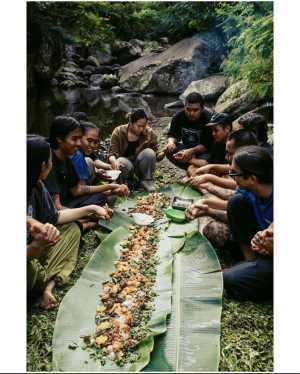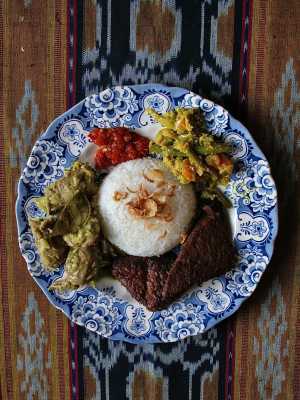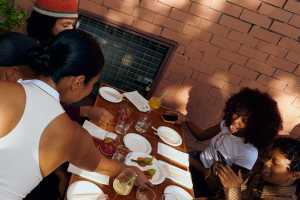In Jakarta, no one asked, ‘Shall we share?’ We just reached across the table. Some instincts are so deeply inherited you don’t notice them – until you’re somewhere they no longer unfold so easily. Dishes were placed in the middle, spoons clinked against shared plates, and nobody left hungry. At the time, it didn’t feel ceremonial. It felt normal.
Moving to London changed that. Here, meals often arrive divided, plated, measured. You order for yourself. You stay in your lane. Suddenly, I started noticing the small absences: the ease of reaching across the table, the way flavours were passed around like conversation. When I began hosting supper clubs years later, it became increasingly clear how much I missed the quiet familiarity of a shared table.
Here, meals often arrive divided, plated, measured
For many across Indonesia, the act of sharing food is so natural, so instinctive, that it rarely requires language. You see it everywhere: a small bowl of sambal nudged toward a friend before they even ask, a bite offered from another’s plate without hesitation, the unspoken understanding that the meal in front of you is not yours alone to consume. It just happens – informally, without fanfare, but as part of the everyday rhythm of life.
One of the most common and casual expressions of this is makan tengah – a deceptively simple style of dining where dishes are placed in the middle of the table to be shared family-style. You see it at home, at roadside warungs, in office lunchrooms, and in simple canteens or neighbourhood eateries. It signals connection and a low-key intimacy. No one needs to ask, “Shall we share?” You just do. That instinct to break bread together is something I’ve carried with me to London – especially through the supper clubs I now host, where makan tengah becomes both inspiration and practice.

Communal dining on a table of banana leaves
I’ve come to realise that communal eating is not just about the food itself, but about what it facilitates: a momentary collapse of stiff social formality, a warm dissolution of distance. Sharing food should be disarming. There’s a kind of soft trust involved when someone you’ve only just gotten to know – a friend of a friend, perhaps – reaches across the table for that spoonful of sambal or helps themselves to a shared dish without hesitation. It echoes the inherent ease of eating among friends or family back home. It shifts something fundamental in the room.
This instinct toward collectivity is rooted in deeper regional traditions across Indonesia, a country made up of more than 17,000 islands, over 1,300 recognised ethnic groups, and a staggering diversity of languages, cuisines, and customs.
Despite this vastness, certain threads of connection run through its many cultures – one of them being the act of always eating together. Across different islands and histories, from the Javanese liwetan to the Sundanese botram and the Balinese megibung, communal dining remains a powerful expression of care, kinship, and cultural memory.
In Java, liwetan is a communal meal where dishes are laid out on banana leaves spread across a woven mat on the floor. It centres around nasi liwet, a savoury rice dish cooked with coconut milk and spices, which originated in Solo (Surakarta), Central Java. Originally associated with royal ceremonies symbolising abundance and gratitude, nasi liwet has since become part of everyday communal life. Liwetan meals are often eaten with bare hands and can mark special occasions, but are just as often a casual gesture of togetherness.
The act of sitting close together, eating from the same surface, and exchanging conversation between mouthfuls turns the meal into a tactile, shared experience. It’s often the matriarch who leads the meal to commence, inviting others to join by gesture rather than instruction.
A scene from one of Rahel Stephanie's London supperclubs
In the Sundanese tradition of botram, the gathering is rooted in the values of cooperation and social harmony. The word refers to a communal meal, often potluck-style, where each person brings something to contribute – rice, fried tempeh, sambal, salted fish. Traditionally held in West Java, botram reflects a spirit of communality that strengthens social ties.
It can happen anywhere people gather informally – whether indoors or outdoors, in homes or community spaces – and is less about abundance than it is about creating a shared experience from what each person can offer. It’s a joyful, slightly spontaneous gathering that often follows communal work, like harvesting or cleaning. Everyone brings a little offering, and the spread becomes greater than the sum of its parts. Botram is not about having enough for everyone to have their own; it’s about making enough by sharing.
In Bali, megibung is a traditional banquet that dates back to the 17th century, introduced by King Anglurah Karangasem to promote solidarity among his soldiers during military campaigns. The practice involves groups of diners – typically five to seven – seated in circles around shared plates of food, often arranged symmetrically on banana leaves.
Each group has a designated leader who ensures everyone eats in balance, following a quiet, respectful cadence. Originally rooted in royal and military contexts, megibung has since evolved into a wider social tradition, now held after religious ceremonies, community events, or family milestones. Even in its most structured form, communal eating here is about dissolving ego and reinforcing unity.

Plating up at Fed by Made in Seminyak, Bali
While each of these traditions – liwetan, botram, and megibung – emerged in different regions and cultural settings, they offer contrasting textures of togetherness. Liwetan is warm and anchoring, built around the richness of nasi liwet – a dish that carries its own history of royal symbolism and familial comfort. Botram is spontaneous and democratic, where the meal emerges from the collective contributions of a group, often after shared labour. And megibung, originally a royal practice, brings a measured choreography to eating, its symmetry and balance reflecting a ceremonial reverence that has since become part of wider Balinese life.
Whilst some have ceremonial origins and others rose from the grassroots, each practice has a deep communality at its centre. These aren’t just ways of eating – they are reflections of different ways of gathering. Each one affirms the same underlying belief: food is not just for the body, but for the bond.
Even tumpeng, the cone-shaped yellow rice often served at celebratory gatherings, embodies this spirit. Traditionally used in selamatan rituals and other significant life events, tumpeng is laden with symbolism: the yellow colour of the rice signifies prosperity and divine blessing, while the conical shape represents a sacred mountain, pointing upward toward God or the ancestors. At its base are assorted side dishes – each chosen intentionally to reflect balance and harmony: vegetables for longevity; eggs for birth and beginnings; and fried foods for festivity. The ritual of cutting the top of the cone and offering it to an elder or guest of honour underscores values of respect, humility, and gratitude. The dish acts as both an offering and an invitation – a centrepiece that brings people together to mark abundance not in terms of wealth, but in community.
Prepping a meal at Carousel
Felipe Diehl
When I first started hosting supper clubs in London, I tried to carry these values with me – the instinct to share, to eat from the same space, to dissolve the boundaries between host and guest. I felt compelled to demonstrate my belief that a meal isn’t complete without company, that food isn’t only for nourishment but also for connection. However, translating that intimacy to a different cultural setting isn’t always seamless. The long table, here, often implies a booking. Plates are personal, borders are implied. In many Western dining settings, sharing tends to be an optional gesture over small plates, while main courses remain strictly individual.
The question, “Are we sharing?” is asked with caution, sometimes even resistance. I’ve found myself among groups of people where that instinct to reach across, to dip into someone else’s dish, doesn’t exist – and I immediately feel like a stranger. Conversely, when I’m with people who share instinctively, without asking, I know: these are my people.
That same sense of knowing came to me recently when I found myself booking a kamayan feast at Lutong Pinoy in Earl’s Court with friends. A kamayan feast – derived from the Tagalog word kamay, meaning ‘hand’ – is a traditional Filipino style of eating where food is laid out on banana leaves and eaten with bare hands, without cutlery or plates. It wasn’t a special occasion. The feast itself was the occasion. There we were, around a long table lined with banana leaves, digging into grilled fish, garlic rice, adobo, and mangoes with our hands, laughing, elbow-to-elbow. It made me realise how much I miss the feeling of eating in a crowd.
The feast itself was the occasion
That instinct to gather around food – to create space through sharing – is being nurtured across the diaspora. Jenny Lau, founder of Celestial Peach, hosts potlucks and rice feasts at the East and Southeast Asian (ESEA) Community Centre in London. Her gatherings centre ESEA experiences, bringing together people who already share cultural threads to come together not just to eat, but to belong.
“I’m interested in exploring non-transactional exchange at all my community events,” Jenny tells me. “In a society where minoritised people find their tradition, heritage and even identity being commodified, I think there’s something empowering in meeting one another on an equal basis – without money changing hands.” At her potlucks, everyone contributes a dish they’ve made. Then they sit down together and eat.
For Jenny, food isn’t just a cultural marker. It’s a means of personal connection. “I don’t like platitudes about how all human beings are just one because we all eat and poop,” she says. “It’s more useful to acknowledge the messy, contradictory narratives in our foodways – and be curious about how they came to be.” She sees herself as a connector “of cultures and ideas” and uses food to help inspire deeper understanding, both of ourselves and of each other.

Nasi campur; an Indonesian delicacy
These gatherings remind me that there is a deeper spirituality to moments of shared food – something that goes beyond taste or nostalgia. In Indonesian kitchens, food isn’t just about feeding people – it’s a kind of silent gesture. The labour behind it, often unspoken and feminised, becomes a way of showing care. There’s intimacy in preparing a meal not for credit, but for connection; in feeding others before feeding yourself.
Tania Murray Li’s work on land and indigenous life lingers in the background here as an underlying influence, offering a lens through which to consider how food, land, and community are deeply intertwined. Though not directly about food, her writing reflects a worldview in which land, community, and sustenance are inextricably linked.
Still, I return to that long table
To gather, to eat, to share – these are not just cultural customs but ways of being that resist capitalist logics of ownership, portioning, and individual consumption.
The long table, then, becomes more than a dining setup. It becomes a quiet resistance – a refusal of division and detachment. It’s a return to something collective and intuitive, even when transplanted far from its origins. In diaspora, that resistance becomes even more layered. Hosting a supper club here means finding a balance – between staying true to what feels natural and adjusting to what’s expected.
There are logistics, of course – tickets, dietary needs, planning – but beneath that is something more tender: the nuanced negotiation of how much to explain, how much to translate, how much to perform. Not everyone at the table will understand the full context, but I try to let the food speak for itself, and let the act of sharing do what it’s always done – build trust, one bite at a time.
Still, I return to that long table.
Stephanie at a pop-up at Fed by Made in Seminyak, Bali
While traditions like liwetan, botram, and megibung have names and distinct cultural anchors, not all communal eating practices are formalised this way. Among the Batak people – the North Sumatran tribe from which I descend – communal dining is also practised.
We traditionally eat from the same tray, an instinctual gathering without formality. We have no label for this... In truth, across Indonesia and the region, many forms of long-table eating exist without needing labels. They happen not because of ceremony, but because food has always been the most natural way to congregate.
Some connections don’t begin with a shared kitchen, but with a shared table. Where intimacy is absent, food often becomes the bridge. I’ve found this over and over again – especially in situations where familiarity hasn’t yet settled.
In Jakarta, after a night out clubbing, the first question was never “What venue are we going to next?” but “Where are we eating?” Over bowls of broth or plates of fried rice, friends old and new came together like the night was just beginning. Food softened the edges between us – an easy, unspoken language that made everything else feel less distant.
At Standar Lokal, a restaurant in the lush green village of Tabanan, I dined on urutan – Balinese spiced and smoked pork sausages – and later heard from the founder that he’d been following my work for some time. He urged me to reach out if I was still around. I returned with a group of friends later that same trip, and he prepared a picnic for us by a nearby waterfall. Another friendship made through food. And food, once again, made more meaningful by the accompaniment of friendship.

Stephanie's Eat With Spoons pop-up at Earth Angels in Melbourne
Something similar happened with Made Dhanu, the chef behind Fed, a restaurant I’d long admired. We first connected over a shared appreciation for each other’s work – a few messages, a pop-up dinner, then a conversation that turned into a collaboration. That eventually became an invitation to something far more rooted: his family’s Kuningan preparations. The ceremony marks the end of Galungan, when ancestral spirits return to the heavens. I arrived at his home to find a quiet kind of bustle.
Pigs were being blessed and prepared for the feast – lawar, sate, and other dishes to be shared with neighbours. We cooked outdoors, side by side, and talked for hours. I wasn’t a lifelong friend, but I was welcomed in fully, without hesitation. That, too, is what food can do: open space, soften borders, bring you immediately into the fold.
There’s something universally recognisable in the act of reaching across the table
At my supper clubs in London, I’ve seen how the instinct to share can still cut through unfamiliarity. It often begins with a guest asking how to eat something they’ve never tried before, or someone tentatively reaching for sambal. As the night unfolds, something shifts. I think of the many times guests have paused before leaving to say the meal tasted like something from their childhood – a memory they hadn’t realised they’d been missing until it returned in a mouthful of rice or a ladle of curry.
Or when two people who had never met before bonded over a dish, going in for seconds and thirds like old friends. These moments often linger with me, and in a city that so often splinters us into individuals, they feel like their own kind of solidarity.
Maybe that’s why I keep doing it – not just cooking Indonesian food – but insisting on serving it in ways that honour the instinct to share. And that could be why the food resonates – not only with other Indonesians, but with people from all kinds of backgrounds. There’s something universally recognisable in the act of reaching across the table, in the warmth of a shared meal. It taps into something older than language. It becomes a way to remember who we are to one another.
The long table doesn’t demand that you speak the same language, only that you sit side by side. It doesn’t require a ceremony to be sacred. It asks for presence. It offers welcome. And, if you let it, it reminds you that eating together can nourish more than the body. It offers something quieter, but just as vital: belonging.
Never miss an issue – subscribe to Foodism to get the best of the London food scene (and beyond) delivered to your door
Never miss an issue – subscribe to Foodism to get the best of the London food scene (and beyond) delivered to your door
Never miss an issue – subscribe to Foodism to get the best of the London food scene (and beyond) delivered to your door
